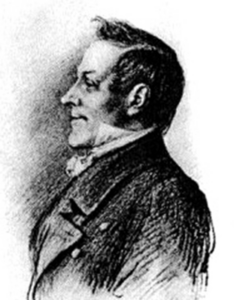Nocturnal scene
(Poet's title: Nachtstück)
Set by Schubert:
D 672
[October 1819]
Wenn über Berge sich der Nebel breitet,
Und Luna mit Gewölken kämpft,
So nimmt der Alte seine Harfe und schreitet
Und singt waldeinwärts und gedämpft:
Du heil’ge Nacht,
Bald ist’s vollbracht,
Bald schlaf ich ihn,
Den langen Schlummer,
Der mich erlöst
Von allem Kummer.
Die grünen Bäume rauschen dann:
Schlaf süß, du guter alter Mann;
Die Gräser lispeln wankend fort:
Wir decken seinen Ruheort;
Und mancher liebe Vogel ruft:
O lasst ihn ruhn in Rasengruft.
Der Alte horcht, der Alte schweigt,
Der Tod hat sich zu ihm geneigt.
When the mist spreads across the mountains
And Luna goes into battle against the clouds,
That is when the old man takes his harp and steps forwards,
And turning towards the forest sings in muffled tones:
“Oh holy night!
It will soon be fulfilled.
I shall soon be sleeping
That long sleep
Which will release
Me from all care.”
The green trees then rustle,
Sleep sweetly, good old man;
The blades of grass whisper as they sway,
We shall cover his place of rest;
And many a dear bird cries out,
Oh let him rest in this trench in the turf! –
The old man pays attention, the old man remains silent –
Death has bent down towards him.
All translations into English that appear on this website, unless otherwise stated, are by Malcolm Wren. You are free to use them on condition that you acknowledge Malcolm Wren as the translator and schubertsong.uk as the source. Unless otherwise stated, the comments and essays that appear after the texts and translations are by Malcolm Wren and are © Copyright.
☙
Themes and images in this text:
Abysses, clefts and crevasses Bards and minstrels Birds Clouds Covers and covering Grass Graves and burials Green Harps and Aeolian harps Hills and mountains Listening Mist and fog Night and the moon Serenades and songs at evening Sleep Trees (general) War, battles and fighting Whispering Woods – large woods and forests (Wald)
It is not a calm night. The wind is pushing clouds across the face of the full moon (‘Luna mit Gewölken kämpft’) and making the blades of grass sway. The leaves and the branches of the trees are rustling. Yet despite this agitation, the sounds that can be heard are increasingly soft. There is no thunder; there are no roaring gusts. The layer of mist that is spreading over the mountain seems to be putting a damper on things. The old man’s final song, with its harp accompaniment, is muted or muffled. The vegetation responds to the song in hushed tones (the leaves rustle, the grass whispers). The birds’ song, with its promise of rest, is faint. The old man has to listen carefully to hear all of these sounds of nature. The diminuendo that has typified the story reaches its only possible conclusion: silence, the silence of death itself.
The poem uses another set of images alongside this progression from activity to stasis, from noise to silence. The poet takes us from the heights to the depths. The story begins with the mist on the mountains and the clouds in the sky. The central narrative has the ancient bard singing into the forest, where the trees rustle in response. We then move down to the grass on the ground and eventually into a cleft in the earth where the old man will lie in his grave. The movement from the sky, to the horizon, to the surface of the earth and down underground is a process of ‘bending’. It is death itself which has bent down.
☙
Original Spelling and notes on the text
Nachtstück
Wenn1 über Berge sich der Nebel breitet,
Und Luna mit Gewölken kämpft,
So nimmt der Alte seine Harfe, und schreitet,
Und singt waldeinwärts und gedämpft:
"Du heil'ge Nacht!
Bald ist's vollbracht.
Bald schlaf ich ihn
Den langen Schlummer,
Der mich erlöst
Von allem2 Kummer."
Die grünen Bäume rauschen dann,
Schlaf süß du guter alter Mann;
Die Gräser lispeln wankend fort,
Wir decken seinen Ruheort;
Und mancher liebe3 Vogel ruft,
O laßt ihn ruh'n in Rasengruft! -
Der Alte horcht, der Alte schweigt -
Der Tod hat sich zu ihm geneigt.
1 When this poem was published in 1824 the word here was ´Wann´(At the point when). It is impossible to know if Schubert made changes like this when he wrote his setting or if he was working from an earlier draft of Mayrhofer´s text.
2 Mayrhofer: jedem (each)
3 Mayrhofer: traute (devoted)
Confirmed by Peter Rastl with Gedichte von Johann Mayrhofer. Wien. Bey Friedrich Volke. 1824
To see an early version of the text, go to page 12 [26 von 212] here: http://digital.onb.ac.at/OnbViewer/viewer.faces?doc=ABO_%2BZ177450902


